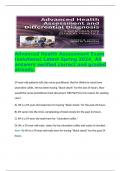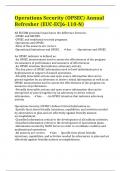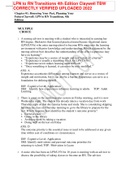Advanced Health Assessment Exam
(solutions) Latest Spring 2024_ All
answers verified correct and graded
already.
59-year-old patients tells the nurse practitioner that he thinks he must have
ulcerative colitis. He has been having "black stools" for the last 24 hours. How
would the nurse practitioner best document THE FACTS for his reason for seeking
care?
A) JM is a 59-year-old male here for having "black stools" for the past 24 hours.
B) JM came into the clinic complaining of black stools for the past 24 hours.
C) JM is a 59-year-old male here for "ulcerative colitis."
D) JM, a 59-year-old male, states he has ulcerative colitis and wants it checked. -
Ans>>A) JM is a 59-year-old male here for having "black stools" for the past 24
hours.
,Chief Complaint(s) The one or more symptoms or concerns causing the patient to
seek care. Make every effort to quote the patient's own words.
A 45-year-old man is in the clinic for a routine physical. During history the patient
states he has been having difficulty sleeping. "I'll be sleeping great and then I
wake up and feel like I can't catch my breath." His symptoms indicates sleep
related symptoms of a certain type of disease, so which question would the NP
want to ask?
A) Have you had a recent sinus infection or URI?
B) Do you have any history of problems with your heart?
C) Do you think it is because it's been so hot at night?
D) When was your last electroencephalogram? - Ans>>B) Do you have any history
of problems with your heart?
Paroxysmal nocturnal dyspnea occurs with heart failure. Lying down increases
volume of intrathoracic blood, and the weakened heart cannot accommodate the
increased load. Classically, the person awakens after 2 hours of sleep, arises, and
flings open a window with the perception of needing fresh air. (Bates, p357)
In assessing a patient's major risk factors for heart disease, which would the nurse
want to include when taking a history?
A) Personality type, high cholesterol, diabetes, smoking
,B) Family history, hypertension, stress, age
C) Alcohol consumption, obesity, diabetes, stress, high cholesterol
D) Smoking, hypertension, obesity, diabetes, and high cholesterol, activity level,
family history - Ans>>D) Smoking, hypertension, obesity, diabetes, and high
cholesterol, activity level, family history
For major risk factors for coronary artery disease, collect data regarding elevated
serum cholesterol, elevated blood pressure, blood glucose levels above 130
mg/dL or known diabetes mellitus, obesity, cigarette smoking, low activity level
(Bates, p358)
In assessing the carotid arteries of an older patient with cardiovascular disease,
the nurse would:
A) palpate the artery in the upper one third of the neck.
B) listen with the bell of the stethoscope to assess for bruits.
C) palpate both arteries simultaneously to compare amplitude.
D) instruct the patient to take slow deep breaths during inspiration. - Ans>>B)
listen with the bell of the stethoscope to assess for bruits.
If cardiovascular disease is suspected, the nurse should auscultate each carotid
artery for the presence of a bruit. The NP should avoid compressing the artery
, because this could create an artificial bruit, and it could compromise circulation if
the carotid artery is already narrowed by atherosclerosis. Avoid excessive
pressure on the carotid sinus area higher in the neck; excessive vagal stimulation
here could slow down the heart rate, especially in older adults. Palpate only one
carotid artery at a time to avoid compromising arterial blood to the brain. The bell
of the stethoscope is best for picking up bruits. The diaphragm is more attuned to
relatively high-pitched sounds; the bell is more sensitive to low-pitched sounds
like bruits. (Bates, 381)
All of the following are true about assessing the jugular venous pressure EXCEPT:
A) The jugular venous pressure is affected by changes in the right atrial filling.
B) The pulsation from the internal jugular vein reflects the left ventricle pressure.
C) The jugular venous pressure is determined by the highest point of oscillation in
the internal jugular vein.
D) The jugular venous pressure is considered abnormal if it is greater than 4 cm
above the sternal angle or greater than 9 cm above the right atrium. - Ans>>B)
The pulsation from the internal jugular vein reflects the left ventricle pressure.
The jugular venous pressure is affected by changes in R atrial filling. The JVP is
abnormal at a height greater than 4 cm and is determined by the highest point of
oscillation. The pulsation from the internal jugular vein is not palpable. (Bates,
p354-355)







